Tesco's Structure, Culture & Factors Influencing Individual Behaviour
VerifiedAdded on 2023/06/18
|10
|2666
|395
Report
AI Summary
This report examines Tesco's organizational culture and structure, exploring how they influence organizational performance and individual employee behavior. It discusses functional and divisional organizational structures, highlighting Tesco's geographically based, decentralized structure that promotes employee empowerment and flexibility. The report also analyzes Tesco's cultural patterns, emphasizing the importance of understanding diverse clientele needs and creating a positive work environment. Leadership styles, including authoritative and democratic approaches, are discussed in relation to their impact on employee motivation and performance. Furthermore, the report identifies factors such as individual abilities, socio-economic background, positivity, perception, and personal presentation as key influences on employee behavior within the workplace. The report concludes by emphasizing the importance of balancing cultural orientation to foster an effective and productive organizational culture at Tesco.
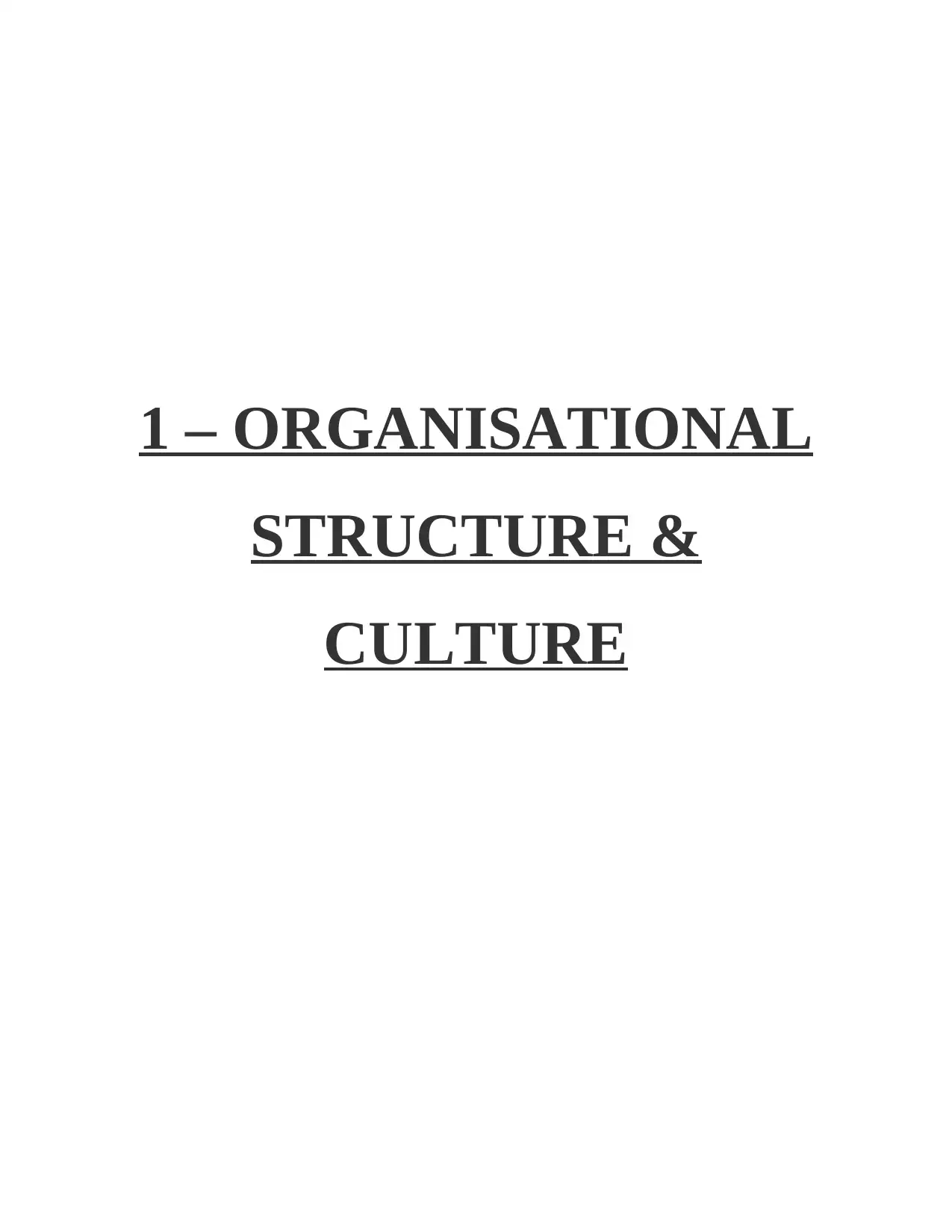
1 – ORGANISATIONAL
STRUCTURE &
CULTURE
STRUCTURE &
CULTURE
Paraphrase This Document
Need a fresh take? Get an instant paraphrase of this document with our AI Paraphraser
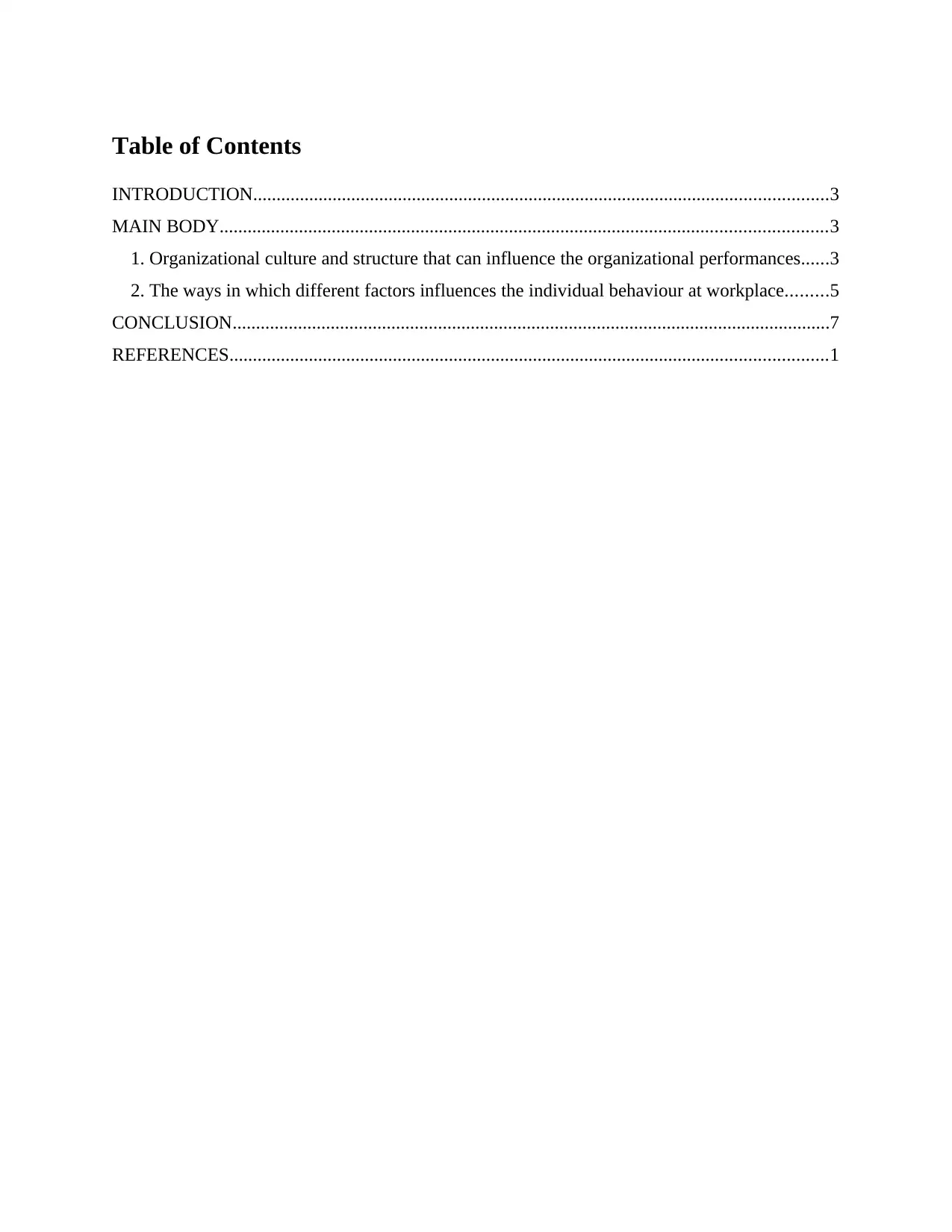
Table of Contents
INTRODUCTION...........................................................................................................................3
MAIN BODY..................................................................................................................................3
1. Organizational culture and structure that can influence the organizational performances......3
2. The ways in which different factors influences the individual behaviour at workplace.........5
CONCLUSION................................................................................................................................7
REFERENCES................................................................................................................................1
INTRODUCTION...........................................................................................................................3
MAIN BODY..................................................................................................................................3
1. Organizational culture and structure that can influence the organizational performances......3
2. The ways in which different factors influences the individual behaviour at workplace.........5
CONCLUSION................................................................................................................................7
REFERENCES................................................................................................................................1
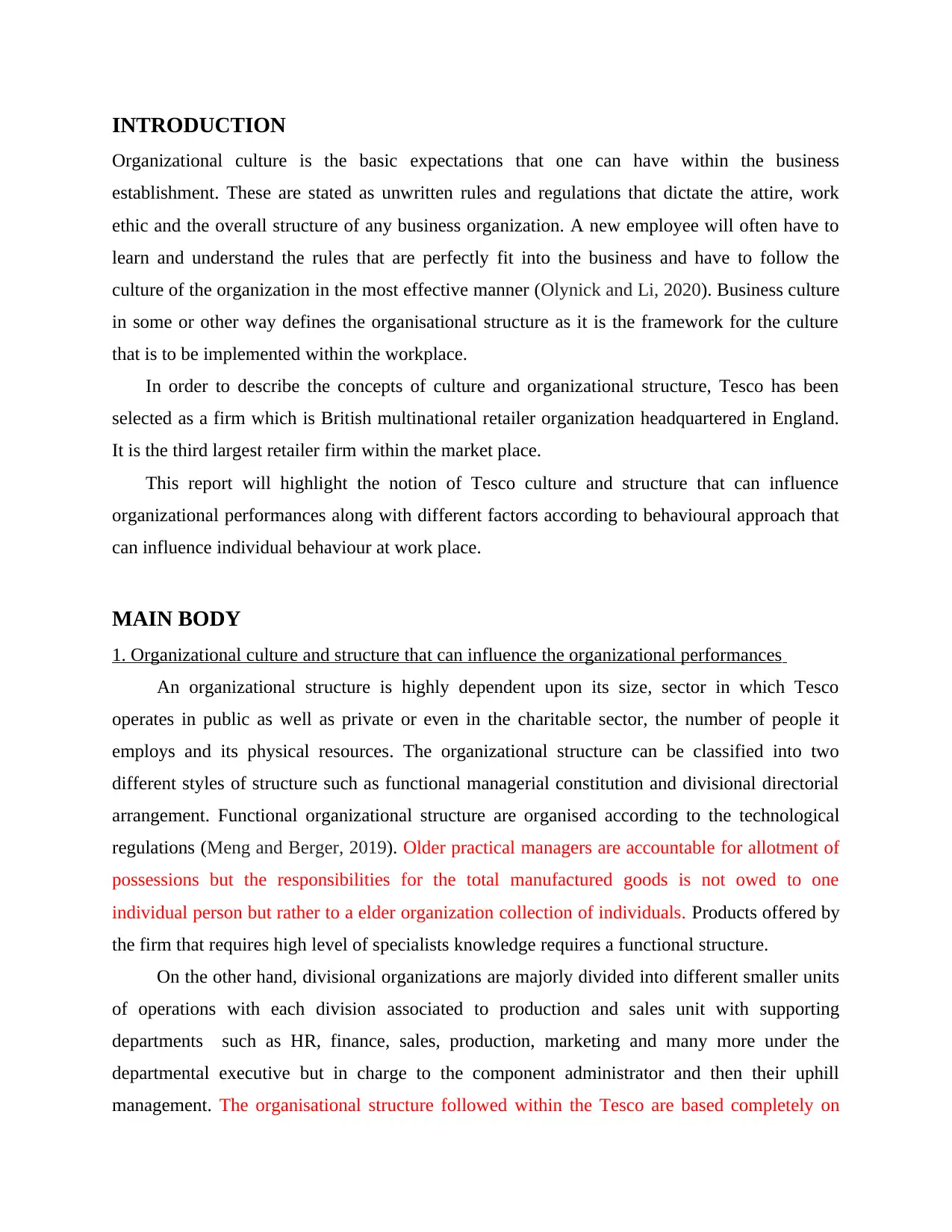
INTRODUCTION
Organizational culture is the basic expectations that one can have within the business
establishment. These are stated as unwritten rules and regulations that dictate the attire, work
ethic and the overall structure of any business organization. A new employee will often have to
learn and understand the rules that are perfectly fit into the business and have to follow the
culture of the organization in the most effective manner (Olynick and Li, 2020). Business culture
in some or other way defines the organisational structure as it is the framework for the culture
that is to be implemented within the workplace.
In order to describe the concepts of culture and organizational structure, Tesco has been
selected as a firm which is British multinational retailer organization headquartered in England.
It is the third largest retailer firm within the market place.
This report will highlight the notion of Tesco culture and structure that can influence
organizational performances along with different factors according to behavioural approach that
can influence individual behaviour at work place.
MAIN BODY
1. Organizational culture and structure that can influence the organizational performances
An organizational structure is highly dependent upon its size, sector in which Tesco
operates in public as well as private or even in the charitable sector, the number of people it
employs and its physical resources. The organizational structure can be classified into two
different styles of structure such as functional managerial constitution and divisional directorial
arrangement. Functional organizational structure are organised according to the technological
regulations (Meng and Berger, 2019). Older practical managers are accountable for allotment of
possessions but the responsibilities for the total manufactured goods is not owed to one
individual person but rather to a elder organization collection of individuals. Products offered by
the firm that requires high level of specialists knowledge requires a functional structure.
On the other hand, divisional organizations are majorly divided into different smaller units
of operations with each division associated to production and sales unit with supporting
departments such as HR, finance, sales, production, marketing and many more under the
departmental executive but in charge to the component administrator and then their uphill
management. The organisational structure followed within the Tesco are based completely on
Organizational culture is the basic expectations that one can have within the business
establishment. These are stated as unwritten rules and regulations that dictate the attire, work
ethic and the overall structure of any business organization. A new employee will often have to
learn and understand the rules that are perfectly fit into the business and have to follow the
culture of the organization in the most effective manner (Olynick and Li, 2020). Business culture
in some or other way defines the organisational structure as it is the framework for the culture
that is to be implemented within the workplace.
In order to describe the concepts of culture and organizational structure, Tesco has been
selected as a firm which is British multinational retailer organization headquartered in England.
It is the third largest retailer firm within the market place.
This report will highlight the notion of Tesco culture and structure that can influence
organizational performances along with different factors according to behavioural approach that
can influence individual behaviour at work place.
MAIN BODY
1. Organizational culture and structure that can influence the organizational performances
An organizational structure is highly dependent upon its size, sector in which Tesco
operates in public as well as private or even in the charitable sector, the number of people it
employs and its physical resources. The organizational structure can be classified into two
different styles of structure such as functional managerial constitution and divisional directorial
arrangement. Functional organizational structure are organised according to the technological
regulations (Meng and Berger, 2019). Older practical managers are accountable for allotment of
possessions but the responsibilities for the total manufactured goods is not owed to one
individual person but rather to a elder organization collection of individuals. Products offered by
the firm that requires high level of specialists knowledge requires a functional structure.
On the other hand, divisional organizations are majorly divided into different smaller units
of operations with each division associated to production and sales unit with supporting
departments such as HR, finance, sales, production, marketing and many more under the
departmental executive but in charge to the component administrator and then their uphill
management. The organisational structure followed within the Tesco are based completely on
⊘ This is a preview!⊘
Do you want full access?
Subscribe today to unlock all pages.

Trusted by 1+ million students worldwide
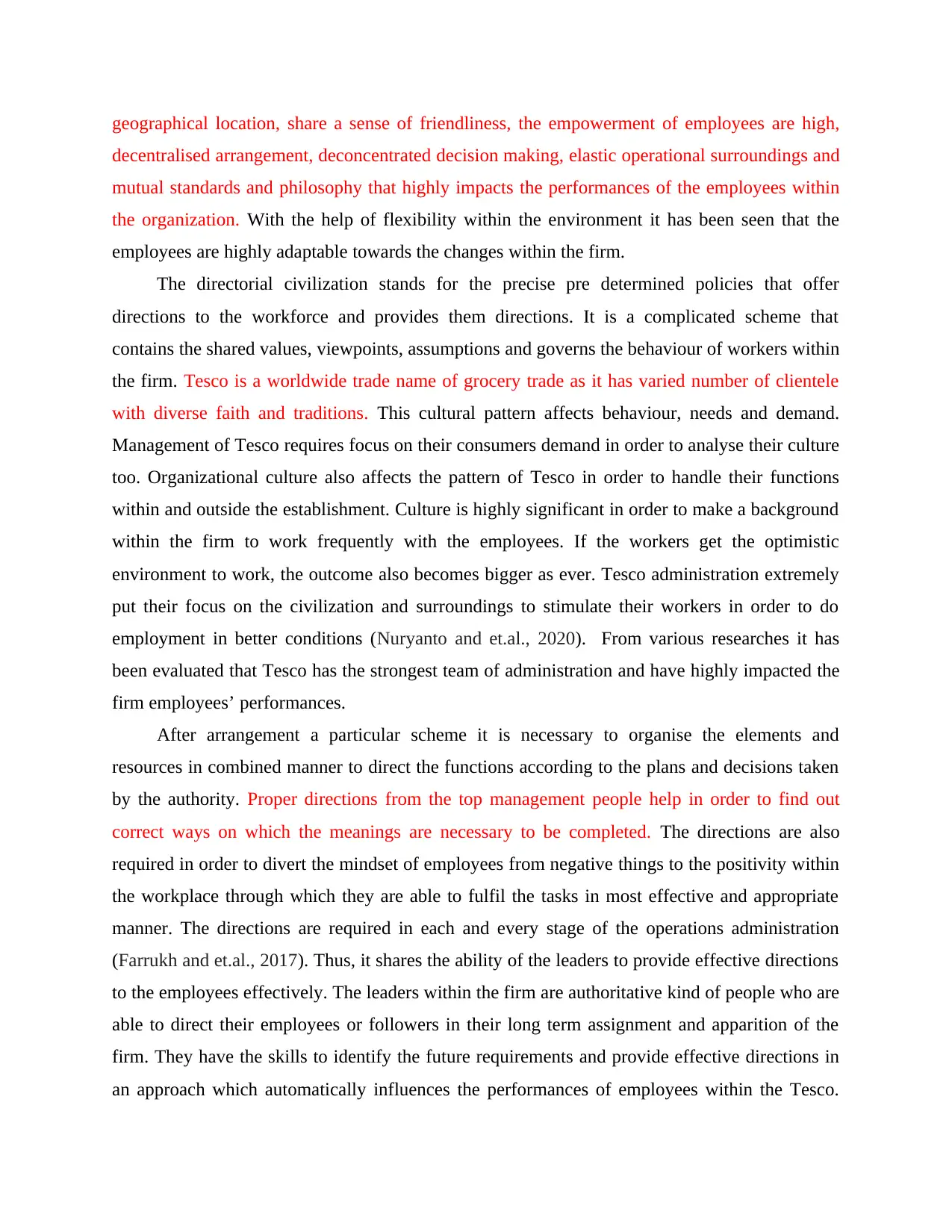
geographical location, share a sense of friendliness, the empowerment of employees are high,
decentralised arrangement, deconcentrated decision making, elastic operational surroundings and
mutual standards and philosophy that highly impacts the performances of the employees within
the organization. With the help of flexibility within the environment it has been seen that the
employees are highly adaptable towards the changes within the firm.
The directorial civilization stands for the precise pre determined policies that offer
directions to the workforce and provides them directions. It is a complicated scheme that
contains the shared values, viewpoints, assumptions and governs the behaviour of workers within
the firm. Tesco is a worldwide trade name of grocery trade as it has varied number of clientele
with diverse faith and traditions. This cultural pattern affects behaviour, needs and demand.
Management of Tesco requires focus on their consumers demand in order to analyse their culture
too. Organizational culture also affects the pattern of Tesco in order to handle their functions
within and outside the establishment. Culture is highly significant in order to make a background
within the firm to work frequently with the employees. If the workers get the optimistic
environment to work, the outcome also becomes bigger as ever. Tesco administration extremely
put their focus on the civilization and surroundings to stimulate their workers in order to do
employment in better conditions (Nuryanto and et.al., 2020). From various researches it has
been evaluated that Tesco has the strongest team of administration and have highly impacted the
firm employees’ performances.
After arrangement a particular scheme it is necessary to organise the elements and
resources in combined manner to direct the functions according to the plans and decisions taken
by the authority. Proper directions from the top management people help in order to find out
correct ways on which the meanings are necessary to be completed. The directions are also
required in order to divert the mindset of employees from negative things to the positivity within
the workplace through which they are able to fulfil the tasks in most effective and appropriate
manner. The directions are required in each and every stage of the operations administration
(Farrukh and et.al., 2017). Thus, it shares the ability of the leaders to provide effective directions
to the employees effectively. The leaders within the firm are authoritative kind of people who are
able to direct their employees or followers in their long term assignment and apparition of the
firm. They have the skills to identify the future requirements and provide effective directions in
an approach which automatically influences the performances of employees within the Tesco.
decentralised arrangement, deconcentrated decision making, elastic operational surroundings and
mutual standards and philosophy that highly impacts the performances of the employees within
the organization. With the help of flexibility within the environment it has been seen that the
employees are highly adaptable towards the changes within the firm.
The directorial civilization stands for the precise pre determined policies that offer
directions to the workforce and provides them directions. It is a complicated scheme that
contains the shared values, viewpoints, assumptions and governs the behaviour of workers within
the firm. Tesco is a worldwide trade name of grocery trade as it has varied number of clientele
with diverse faith and traditions. This cultural pattern affects behaviour, needs and demand.
Management of Tesco requires focus on their consumers demand in order to analyse their culture
too. Organizational culture also affects the pattern of Tesco in order to handle their functions
within and outside the establishment. Culture is highly significant in order to make a background
within the firm to work frequently with the employees. If the workers get the optimistic
environment to work, the outcome also becomes bigger as ever. Tesco administration extremely
put their focus on the civilization and surroundings to stimulate their workers in order to do
employment in better conditions (Nuryanto and et.al., 2020). From various researches it has
been evaluated that Tesco has the strongest team of administration and have highly impacted the
firm employees’ performances.
After arrangement a particular scheme it is necessary to organise the elements and
resources in combined manner to direct the functions according to the plans and decisions taken
by the authority. Proper directions from the top management people help in order to find out
correct ways on which the meanings are necessary to be completed. The directions are also
required in order to divert the mindset of employees from negative things to the positivity within
the workplace through which they are able to fulfil the tasks in most effective and appropriate
manner. The directions are required in each and every stage of the operations administration
(Farrukh and et.al., 2017). Thus, it shares the ability of the leaders to provide effective directions
to the employees effectively. The leaders within the firm are authoritative kind of people who are
able to direct their employees or followers in their long term assignment and apparition of the
firm. They have the skills to identify the future requirements and provide effective directions in
an approach which automatically influences the performances of employees within the Tesco.
Paraphrase This Document
Need a fresh take? Get an instant paraphrase of this document with our AI Paraphraser
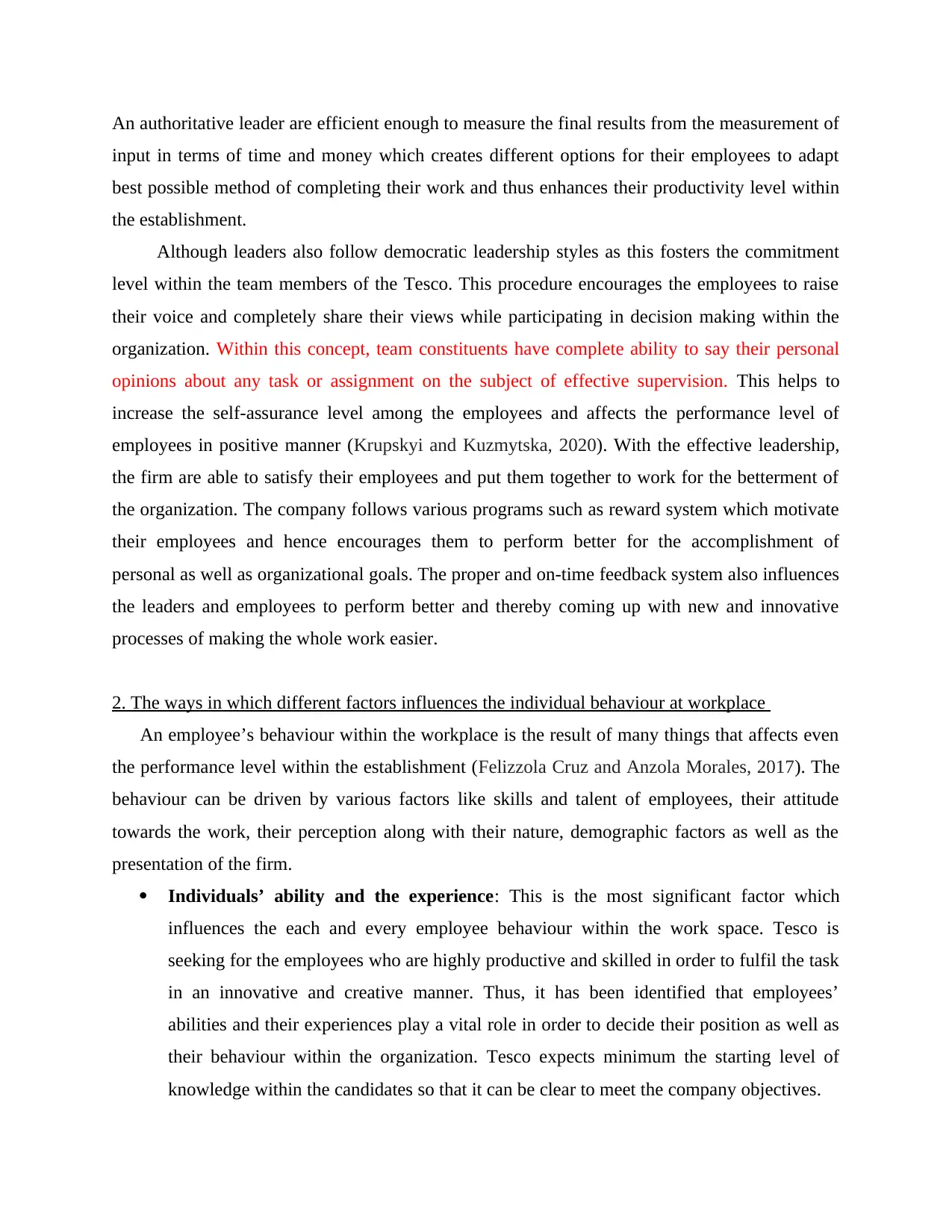
An authoritative leader are efficient enough to measure the final results from the measurement of
input in terms of time and money which creates different options for their employees to adapt
best possible method of completing their work and thus enhances their productivity level within
the establishment.
Although leaders also follow democratic leadership styles as this fosters the commitment
level within the team members of the Tesco. This procedure encourages the employees to raise
their voice and completely share their views while participating in decision making within the
organization. Within this concept, team constituents have complete ability to say their personal
opinions about any task or assignment on the subject of effective supervision. This helps to
increase the self-assurance level among the employees and affects the performance level of
employees in positive manner (Krupskyi and Kuzmytska, 2020). With the effective leadership,
the firm are able to satisfy their employees and put them together to work for the betterment of
the organization. The company follows various programs such as reward system which motivate
their employees and hence encourages them to perform better for the accomplishment of
personal as well as organizational goals. The proper and on-time feedback system also influences
the leaders and employees to perform better and thereby coming up with new and innovative
processes of making the whole work easier.
2. The ways in which different factors influences the individual behaviour at workplace
An employee’s behaviour within the workplace is the result of many things that affects even
the performance level within the establishment (Felizzola Cruz and Anzola Morales, 2017). The
behaviour can be driven by various factors like skills and talent of employees, their attitude
towards the work, their perception along with their nature, demographic factors as well as the
presentation of the firm.
Individuals’ ability and the experience: This is the most significant factor which
influences the each and every employee behaviour within the work space. Tesco is
seeking for the employees who are highly productive and skilled in order to fulfil the task
in an innovative and creative manner. Thus, it has been identified that employees’
abilities and their experiences play a vital role in order to decide their position as well as
their behaviour within the organization. Tesco expects minimum the starting level of
knowledge within the candidates so that it can be clear to meet the company objectives.
input in terms of time and money which creates different options for their employees to adapt
best possible method of completing their work and thus enhances their productivity level within
the establishment.
Although leaders also follow democratic leadership styles as this fosters the commitment
level within the team members of the Tesco. This procedure encourages the employees to raise
their voice and completely share their views while participating in decision making within the
organization. Within this concept, team constituents have complete ability to say their personal
opinions about any task or assignment on the subject of effective supervision. This helps to
increase the self-assurance level among the employees and affects the performance level of
employees in positive manner (Krupskyi and Kuzmytska, 2020). With the effective leadership,
the firm are able to satisfy their employees and put them together to work for the betterment of
the organization. The company follows various programs such as reward system which motivate
their employees and hence encourages them to perform better for the accomplishment of
personal as well as organizational goals. The proper and on-time feedback system also influences
the leaders and employees to perform better and thereby coming up with new and innovative
processes of making the whole work easier.
2. The ways in which different factors influences the individual behaviour at workplace
An employee’s behaviour within the workplace is the result of many things that affects even
the performance level within the establishment (Felizzola Cruz and Anzola Morales, 2017). The
behaviour can be driven by various factors like skills and talent of employees, their attitude
towards the work, their perception along with their nature, demographic factors as well as the
presentation of the firm.
Individuals’ ability and the experience: This is the most significant factor which
influences the each and every employee behaviour within the work space. Tesco is
seeking for the employees who are highly productive and skilled in order to fulfil the task
in an innovative and creative manner. Thus, it has been identified that employees’
abilities and their experiences play a vital role in order to decide their position as well as
their behaviour within the organization. Tesco expects minimum the starting level of
knowledge within the candidates so that it can be clear to meet the company objectives.
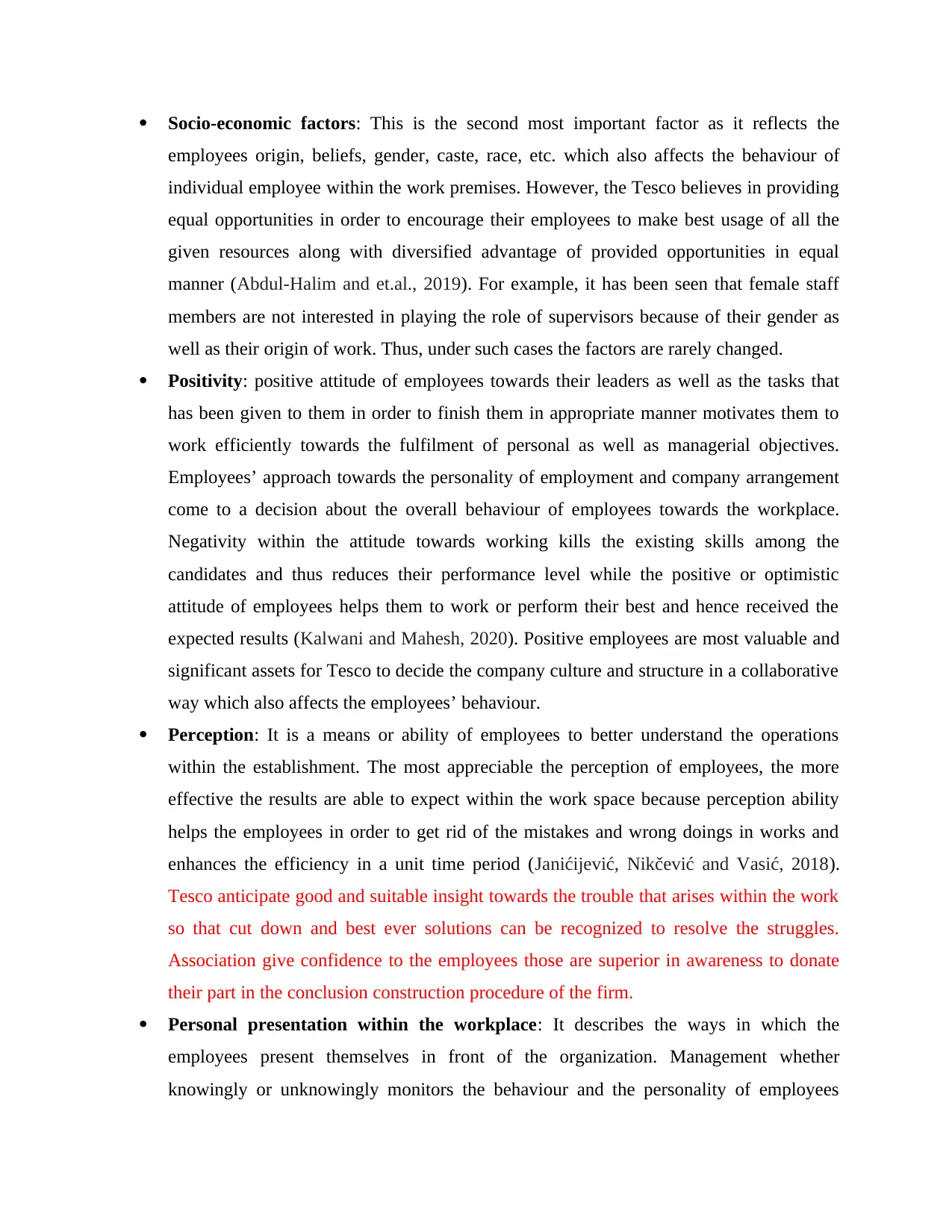
Socio-economic factors: This is the second most important factor as it reflects the
employees origin, beliefs, gender, caste, race, etc. which also affects the behaviour of
individual employee within the work premises. However, the Tesco believes in providing
equal opportunities in order to encourage their employees to make best usage of all the
given resources along with diversified advantage of provided opportunities in equal
manner (Abdul-Halim and et.al., 2019). For example, it has been seen that female staff
members are not interested in playing the role of supervisors because of their gender as
well as their origin of work. Thus, under such cases the factors are rarely changed.
Positivity: positive attitude of employees towards their leaders as well as the tasks that
has been given to them in order to finish them in appropriate manner motivates them to
work efficiently towards the fulfilment of personal as well as managerial objectives.
Employees’ approach towards the personality of employment and company arrangement
come to a decision about the overall behaviour of employees towards the workplace.
Negativity within the attitude towards working kills the existing skills among the
candidates and thus reduces their performance level while the positive or optimistic
attitude of employees helps them to work or perform their best and hence received the
expected results (Kalwani and Mahesh, 2020). Positive employees are most valuable and
significant assets for Tesco to decide the company culture and structure in a collaborative
way which also affects the employees’ behaviour.
Perception: It is a means or ability of employees to better understand the operations
within the establishment. The most appreciable the perception of employees, the more
effective the results are able to expect within the work space because perception ability
helps the employees in order to get rid of the mistakes and wrong doings in works and
enhances the efficiency in a unit time period (Janićijević, Nikčević and Vasić, 2018).
Tesco anticipate good and suitable insight towards the trouble that arises within the work
so that cut down and best ever solutions can be recognized to resolve the struggles.
Association give confidence to the employees those are superior in awareness to donate
their part in the conclusion construction procedure of the firm.
Personal presentation within the workplace: It describes the ways in which the
employees present themselves in front of the organization. Management whether
knowingly or unknowingly monitors the behaviour and the personality of employees
employees origin, beliefs, gender, caste, race, etc. which also affects the behaviour of
individual employee within the work premises. However, the Tesco believes in providing
equal opportunities in order to encourage their employees to make best usage of all the
given resources along with diversified advantage of provided opportunities in equal
manner (Abdul-Halim and et.al., 2019). For example, it has been seen that female staff
members are not interested in playing the role of supervisors because of their gender as
well as their origin of work. Thus, under such cases the factors are rarely changed.
Positivity: positive attitude of employees towards their leaders as well as the tasks that
has been given to them in order to finish them in appropriate manner motivates them to
work efficiently towards the fulfilment of personal as well as managerial objectives.
Employees’ approach towards the personality of employment and company arrangement
come to a decision about the overall behaviour of employees towards the workplace.
Negativity within the attitude towards working kills the existing skills among the
candidates and thus reduces their performance level while the positive or optimistic
attitude of employees helps them to work or perform their best and hence received the
expected results (Kalwani and Mahesh, 2020). Positive employees are most valuable and
significant assets for Tesco to decide the company culture and structure in a collaborative
way which also affects the employees’ behaviour.
Perception: It is a means or ability of employees to better understand the operations
within the establishment. The most appreciable the perception of employees, the more
effective the results are able to expect within the work space because perception ability
helps the employees in order to get rid of the mistakes and wrong doings in works and
enhances the efficiency in a unit time period (Janićijević, Nikčević and Vasić, 2018).
Tesco anticipate good and suitable insight towards the trouble that arises within the work
so that cut down and best ever solutions can be recognized to resolve the struggles.
Association give confidence to the employees those are superior in awareness to donate
their part in the conclusion construction procedure of the firm.
Personal presentation within the workplace: It describes the ways in which the
employees present themselves in front of the organization. Management whether
knowingly or unknowingly monitors the behaviour and the personality of employees
⊘ This is a preview!⊘
Do you want full access?
Subscribe today to unlock all pages.

Trusted by 1+ million students worldwide
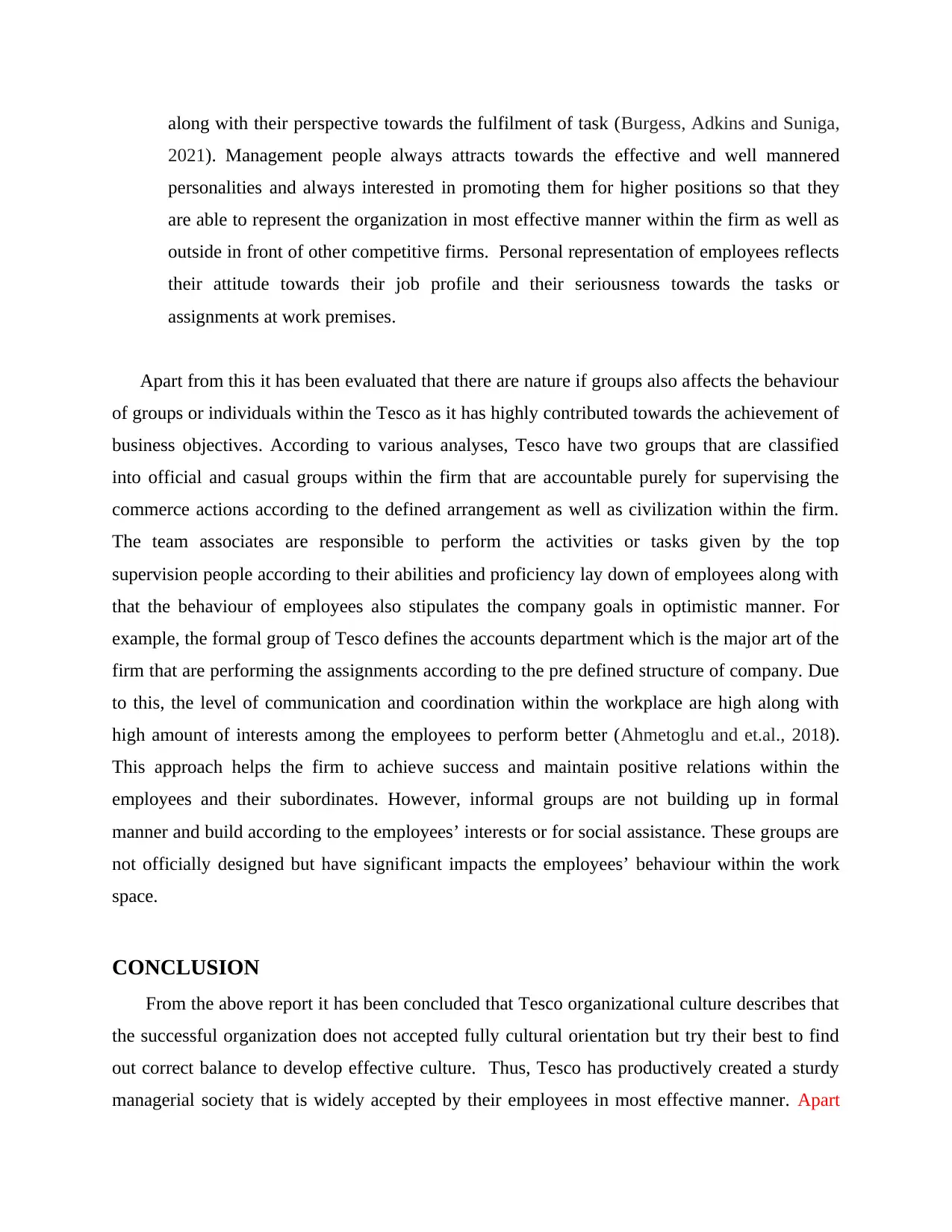
along with their perspective towards the fulfilment of task (Burgess, Adkins and Suniga,
2021). Management people always attracts towards the effective and well mannered
personalities and always interested in promoting them for higher positions so that they
are able to represent the organization in most effective manner within the firm as well as
outside in front of other competitive firms. Personal representation of employees reflects
their attitude towards their job profile and their seriousness towards the tasks or
assignments at work premises.
Apart from this it has been evaluated that there are nature if groups also affects the behaviour
of groups or individuals within the Tesco as it has highly contributed towards the achievement of
business objectives. According to various analyses, Tesco have two groups that are classified
into official and casual groups within the firm that are accountable purely for supervising the
commerce actions according to the defined arrangement as well as civilization within the firm.
The team associates are responsible to perform the activities or tasks given by the top
supervision people according to their abilities and proficiency lay down of employees along with
that the behaviour of employees also stipulates the company goals in optimistic manner. For
example, the formal group of Tesco defines the accounts department which is the major art of the
firm that are performing the assignments according to the pre defined structure of company. Due
to this, the level of communication and coordination within the workplace are high along with
high amount of interests among the employees to perform better (Ahmetoglu and et.al., 2018).
This approach helps the firm to achieve success and maintain positive relations within the
employees and their subordinates. However, informal groups are not building up in formal
manner and build according to the employees’ interests or for social assistance. These groups are
not officially designed but have significant impacts the employees’ behaviour within the work
space.
CONCLUSION
From the above report it has been concluded that Tesco organizational culture describes that
the successful organization does not accepted fully cultural orientation but try their best to find
out correct balance to develop effective culture. Thus, Tesco has productively created a sturdy
managerial society that is widely accepted by their employees in most effective manner. Apart
2021). Management people always attracts towards the effective and well mannered
personalities and always interested in promoting them for higher positions so that they
are able to represent the organization in most effective manner within the firm as well as
outside in front of other competitive firms. Personal representation of employees reflects
their attitude towards their job profile and their seriousness towards the tasks or
assignments at work premises.
Apart from this it has been evaluated that there are nature if groups also affects the behaviour
of groups or individuals within the Tesco as it has highly contributed towards the achievement of
business objectives. According to various analyses, Tesco have two groups that are classified
into official and casual groups within the firm that are accountable purely for supervising the
commerce actions according to the defined arrangement as well as civilization within the firm.
The team associates are responsible to perform the activities or tasks given by the top
supervision people according to their abilities and proficiency lay down of employees along with
that the behaviour of employees also stipulates the company goals in optimistic manner. For
example, the formal group of Tesco defines the accounts department which is the major art of the
firm that are performing the assignments according to the pre defined structure of company. Due
to this, the level of communication and coordination within the workplace are high along with
high amount of interests among the employees to perform better (Ahmetoglu and et.al., 2018).
This approach helps the firm to achieve success and maintain positive relations within the
employees and their subordinates. However, informal groups are not building up in formal
manner and build according to the employees’ interests or for social assistance. These groups are
not officially designed but have significant impacts the employees’ behaviour within the work
space.
CONCLUSION
From the above report it has been concluded that Tesco organizational culture describes that
the successful organization does not accepted fully cultural orientation but try their best to find
out correct balance to develop effective culture. Thus, Tesco has productively created a sturdy
managerial society that is widely accepted by their employees in most effective manner. Apart
Paraphrase This Document
Need a fresh take? Get an instant paraphrase of this document with our AI Paraphraser
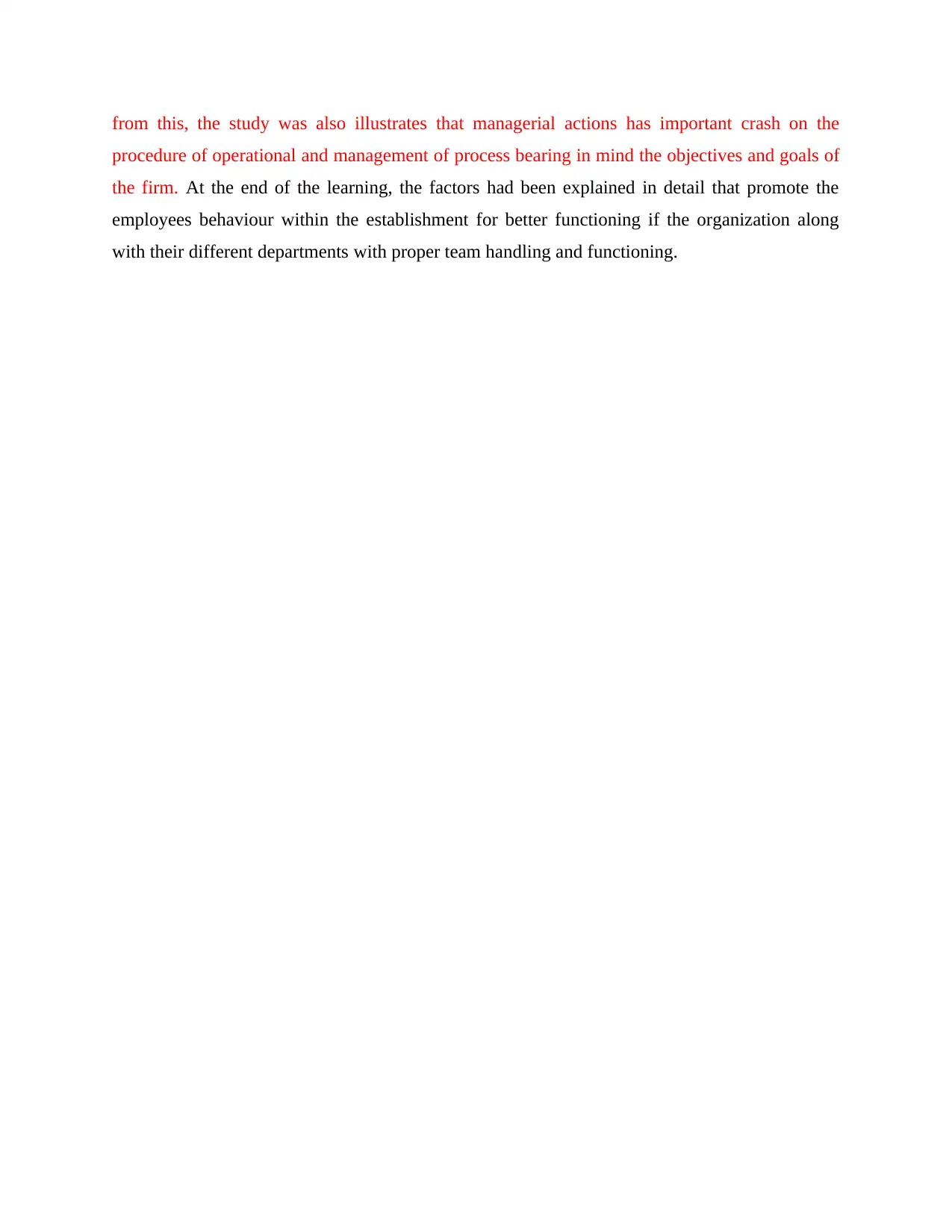
from this, the study was also illustrates that managerial actions has important crash on the
procedure of operational and management of process bearing in mind the objectives and goals of
the firm. At the end of the learning, the factors had been explained in detail that promote the
employees behaviour within the establishment for better functioning if the organization along
with their different departments with proper team handling and functioning.
procedure of operational and management of process bearing in mind the objectives and goals of
the firm. At the end of the learning, the factors had been explained in detail that promote the
employees behaviour within the establishment for better functioning if the organization along
with their different departments with proper team handling and functioning.
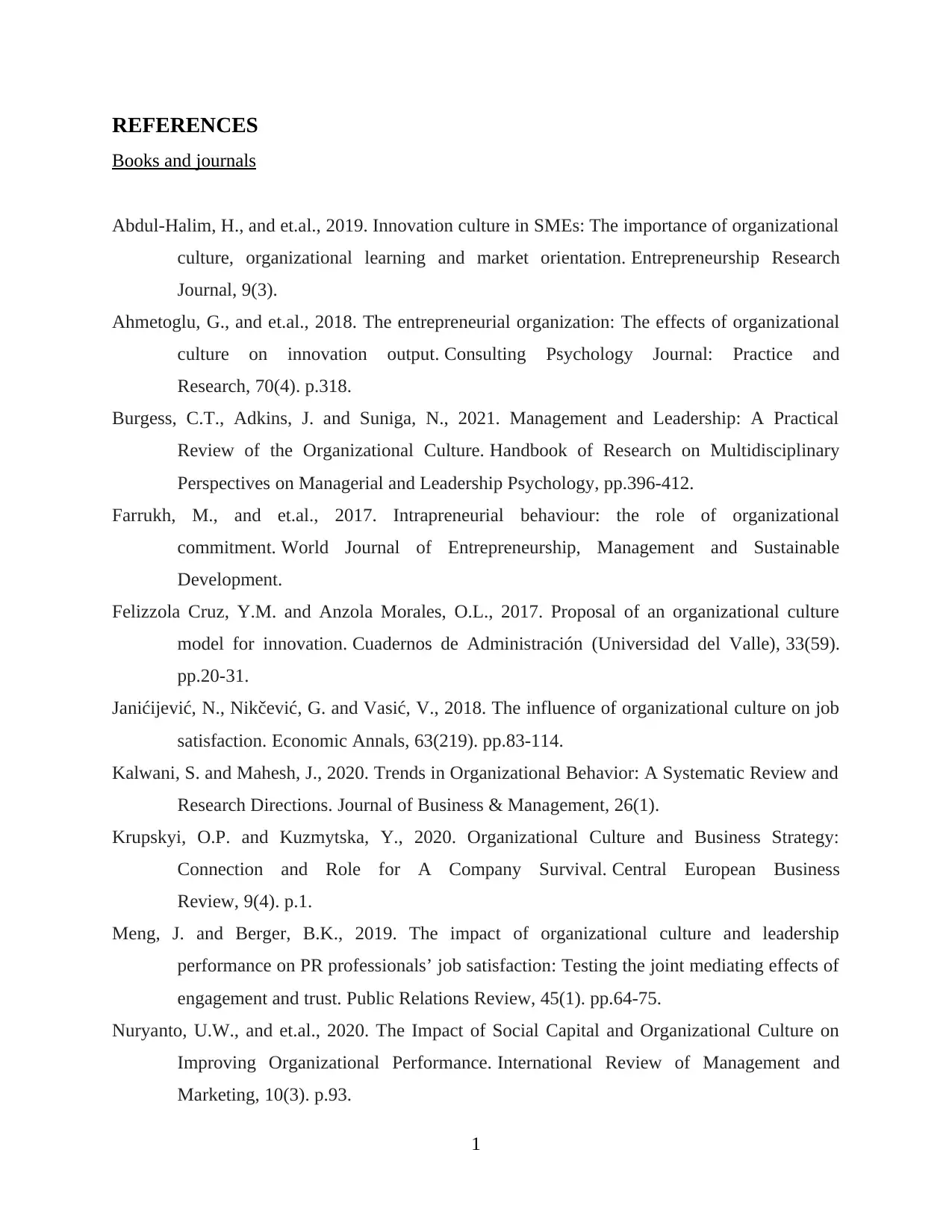
REFERENCES
Books and journals
Abdul-Halim, H., and et.al., 2019. Innovation culture in SMEs: The importance of organizational
culture, organizational learning and market orientation. Entrepreneurship Research
Journal, 9(3).
Ahmetoglu, G., and et.al., 2018. The entrepreneurial organization: The effects of organizational
culture on innovation output. Consulting Psychology Journal: Practice and
Research, 70(4). p.318.
Burgess, C.T., Adkins, J. and Suniga, N., 2021. Management and Leadership: A Practical
Review of the Organizational Culture. Handbook of Research on Multidisciplinary
Perspectives on Managerial and Leadership Psychology, pp.396-412.
Farrukh, M., and et.al., 2017. Intrapreneurial behaviour: the role of organizational
commitment. World Journal of Entrepreneurship, Management and Sustainable
Development.
Felizzola Cruz, Y.M. and Anzola Morales, O.L., 2017. Proposal of an organizational culture
model for innovation. Cuadernos de Administración (Universidad del Valle), 33(59).
pp.20-31.
Janićijević, N., Nikčević, G. and Vasić, V., 2018. The influence of organizational culture on job
satisfaction. Economic Annals, 63(219). pp.83-114.
Kalwani, S. and Mahesh, J., 2020. Trends in Organizational Behavior: A Systematic Review and
Research Directions. Journal of Business & Management, 26(1).
Krupskyi, O.P. and Kuzmytska, Y., 2020. Organizational Culture and Business Strategy:
Connection and Role for A Company Survival. Central European Business
Review, 9(4). p.1.
Meng, J. and Berger, B.K., 2019. The impact of organizational culture and leadership
performance on PR professionals’ job satisfaction: Testing the joint mediating effects of
engagement and trust. Public Relations Review, 45(1). pp.64-75.
Nuryanto, U.W., and et.al., 2020. The Impact of Social Capital and Organizational Culture on
Improving Organizational Performance. International Review of Management and
Marketing, 10(3). p.93.
1
Books and journals
Abdul-Halim, H., and et.al., 2019. Innovation culture in SMEs: The importance of organizational
culture, organizational learning and market orientation. Entrepreneurship Research
Journal, 9(3).
Ahmetoglu, G., and et.al., 2018. The entrepreneurial organization: The effects of organizational
culture on innovation output. Consulting Psychology Journal: Practice and
Research, 70(4). p.318.
Burgess, C.T., Adkins, J. and Suniga, N., 2021. Management and Leadership: A Practical
Review of the Organizational Culture. Handbook of Research on Multidisciplinary
Perspectives on Managerial and Leadership Psychology, pp.396-412.
Farrukh, M., and et.al., 2017. Intrapreneurial behaviour: the role of organizational
commitment. World Journal of Entrepreneurship, Management and Sustainable
Development.
Felizzola Cruz, Y.M. and Anzola Morales, O.L., 2017. Proposal of an organizational culture
model for innovation. Cuadernos de Administración (Universidad del Valle), 33(59).
pp.20-31.
Janićijević, N., Nikčević, G. and Vasić, V., 2018. The influence of organizational culture on job
satisfaction. Economic Annals, 63(219). pp.83-114.
Kalwani, S. and Mahesh, J., 2020. Trends in Organizational Behavior: A Systematic Review and
Research Directions. Journal of Business & Management, 26(1).
Krupskyi, O.P. and Kuzmytska, Y., 2020. Organizational Culture and Business Strategy:
Connection and Role for A Company Survival. Central European Business
Review, 9(4). p.1.
Meng, J. and Berger, B.K., 2019. The impact of organizational culture and leadership
performance on PR professionals’ job satisfaction: Testing the joint mediating effects of
engagement and trust. Public Relations Review, 45(1). pp.64-75.
Nuryanto, U.W., and et.al., 2020. The Impact of Social Capital and Organizational Culture on
Improving Organizational Performance. International Review of Management and
Marketing, 10(3). p.93.
1
⊘ This is a preview!⊘
Do you want full access?
Subscribe today to unlock all pages.

Trusted by 1+ million students worldwide

Olynick, J. and Li, H.Z., 2020. Organizational culture and its relationship with employee stress,
enjoyment of work and productivity. Int. J. Psychol. Stud, 12. p.14.
2
enjoyment of work and productivity. Int. J. Psychol. Stud, 12. p.14.
2
1 out of 10
Related Documents
Your All-in-One AI-Powered Toolkit for Academic Success.
+13062052269
info@desklib.com
Available 24*7 on WhatsApp / Email
![[object Object]](/_next/static/media/star-bottom.7253800d.svg)
Unlock your academic potential
Copyright © 2020–2025 A2Z Services. All Rights Reserved. Developed and managed by ZUCOL.





